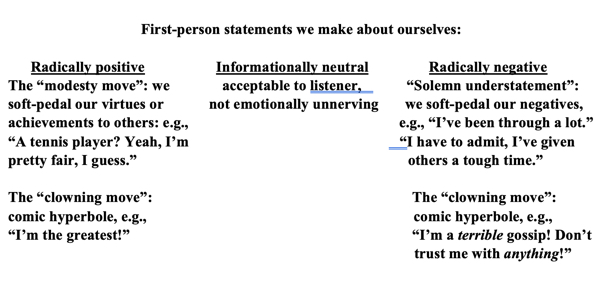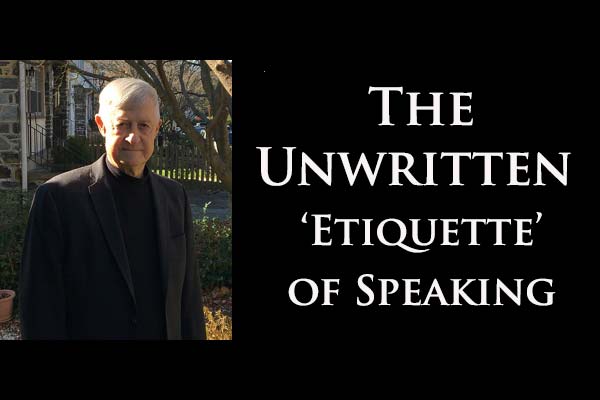The Peculiar, Unwritten “Etiquette” of Speaking
By WTP Writer Richard Wertime
Woven Tale Press writer Richard Wertime reflects
on the craft of fiction in an ongoing series of craft notes
“To be, or not to be—that is the question.”
(Hamlet, Act III, scene i, line 66)
Erving Goffman offers us a marvelous distinction in the opening chapter of The Presentation of Self in Everyday Life.
As we listen, he says, to others we’re receiving two types of information from them—the information they “give” us and, at the same time, the information they “give off.” The first of these two will be performative in nature, indicating the speaker’s wish to “shape” the view we have of them. The second is more revealing, constituting as it does what “escapes” from the person, entirely beyond the speaker’s control—that disclosure being one the speaker will be only minimally aware of. (For the ancient Greeks, we’ll note, an individual’s “essence” was an elusive little daimon sitting over the person’s shoulder, forever out of view—except to others, for whom, in turn, it was forever on display!)
These distinctions of Goffman’s yield deep reverberations. They can help us peer further into the writing (and reading) of dialogue, and understand how the “claims” that people make whenever they’re speaking—claims about themselves, especially—are fraught with hazards and complications. They open to view, too, what I’ll call here for convenience the “etiquette” of speaking—that peculiar body of unwritten rules, taboos as well, that we’re all expected to learn and abide by… but which nobody ever teaches us!
Goffman suggests a pair of vital questions:
What effect does it have on our view of another person if the information they “give” us is in conflict, at odds, with the information they’re also “giving off”?
And then, inversely: What conclusions do we draw when we observe, in a person’s conduct, that the two types of information align with each other?
What makes these questions so tantalizing for us is the door they throw open to a pair of key issues: (a) what is it for a person to “appear” before others, especially in a forum that’s in any way public? and (b) what power is conferred on those “observing” others in any sort of public context? The dynamics of spectatorship come into play here.
“Preparing a face to meet the faces that you meet”: the anxiety of self-exposure
Eliot’s line from “Prufrock” (it’s a cosmeticizing image, let’s not overlook!) reminds us how anxious we’re liable to become when called upon to “expose” ourselves, especially in settings that aren’t intimate ones, ones couched in friendship. Required to speak in public, we feel naked, judged, defenseless in the face of the scrutiny of others—routinely failing to observe, in such cases, that it is we who confer the power to judge us on others! (Eleanor Roosevelt, often disparaged by the press corps, retorted, “You may not demean me without my permission.”) Our “public” thus becomes judge and jury alike, suggesting that we’re on trial in both senses of the word—“trial” both, that is, as judicial proceeding and as unwelcome ordeal. And so, in a curious way, despite what the law says, we find ourselves fearing that others will find us guilty until we can prove ourselves innocent. The deck is stacked against us!
These anxieties of ours, while perhaps paranoic, aren’t in fact without foundation. That it takes an essential courage to appear at all in public has been well understood for a very long time,* and the scrutiny of others is well-nigh unavoidable, since we all make “judgments” whether we’re aware of it or not. When—to turn back to those italicized questions—the claims that we make about ourselves don’t jibe—don’t align with—the information we “give off” (think of Nixon in disgrace as he’s boarding the helicopter, president no longer, smiling and waving to the crowd, making the victory sign!), we look foolish, “not together,” painfully unaware of our being at essential odds with ourselves. In reverse, when the two sorts of information do align, we’ll regard the person as enjoying self-awareness, as having composure, at least for the moment (it can all change quickly), and therefore possessing some degree of adultness. Serious people!
Let’s ground this in dialogue. First example:
“ … Oh, hey, did I just offend you by saying that?” Tom asked.
Rob smiled nervously. “No, no, it’s okay! I take everything as a compliment!”
Example two:
“ … Oh, hey, did I just offend you by saying that?” asked Frank.
Her gaze lowered, Kathy paused. “It’s the sort of comment, Frank, that you ought to know better than be making by now.”
The second scenario might be a strained one for both of them, at least momentarily, but Frank can’t not respect Kathy for her directness—and the reader of the passage (were it appearing in a story) couldn’t not see her as self-aware—and dignified. Rob, in the first scenario, squirming in denial and in visible discomfort, clearly isn’t “up” to handling the moment. It’s painful to watch him!
(*For those few of us who are naturally fearless, says Hannah Arendt, possessing the courage to appear in public constitutes no virtue.)
The “etiquette” of speaking: the curious hazards of extravagant self-disclosures
And speaking of painful…
Want to make people nervous?—provoke them to laughter that will leave them embarrassed, that spasmodic sort of laughter we sometimes break out in, beyond our control? Or, if not nervous laughter, leave them squirming in pain at what they’re enduring?
Then do this!—make some extravagant “claim” about yourself, offer a self-disclosure at the radical extremes, either negative or positive, with an entirely straight face, no irony in your tone, a claim that you make in (as we say) all sincerity…
… And watch your audience lose its composure! Go ahead, try it! (It works with individuals as well as with groups, though with groups more readily.) Say something like this:
“I am a very excellent individual—truly unique. You’re really very fortunate to have me among you. I hope you appreciate that, the rare opportunity me being here affords you.”
Or this:
“You’re so lucky to have me. I’m the best thing since baked bread that has happened around here! Truly superior! Really.”
Or, at the negative extremes (remember, now, always: no irony in your tone, and with an entirely straight face):
“I should tell you I’m a pervert. An extremely troubled person. I’m also highly sensitive! So, you owe me very, very special consideration.”
“Oh, noooooo!” comes the response! “You are just not allowed to TALK that way! It’s against all the the rules!!!” And indeed, it is—against all the rules. But WHAT rules? Where are they? –And who ever made those rules up anyhow?
What we’re looking at here are some of the most potent taboos that exist in our ordinary conventions of speaking—strictures against utterance of the sorts we deem verboten, which strictures, however, are written down nowhere… and yet all of us must learn them, or fail to do so at our peril! –The failure resulting in our being tactless, clueless, “terminally sincere,” as is sometimes said of us. As Kenneth Burke tells us (I must paraphrase) in Language as Symbolic Action,
To use language maturely, we must appreciate irony spontaneously.
… irony, of course, meriting more consideration than time allows for here; but Burke’s observation points the way, as do Goffman’s insights, to some organizing principles regarding several things: (a) what we can say about ourselves without provoking ridicule or enduring social censure, (b) the means available to us for expressing, in acceptable ways, radically positive or negative things about ourselves; and (c) the liberty we enjoy in saying things about other people that’s very much not granted when we speak about ourselves!
Claims and disclaimers: the elaborate mechanics of “indirection”
Disclaimers, so familiar in our daily acts of modesty (“Oh, I can’t take any credit for that”), are of course, in themselves, “claims” in not-claiming—disavowals depending on the listener to “adjust”—what is being said isn’t at all what’s being meant. The adjustment is the one that irony requires, which “dislocates” the implicit from the ostensible, and “victimizes” us if our understanding is naïve, if we can’t make the required “leap” from the expressed to the intended (Wayne C. Booth, A Rhetoric of Irony).
But isn’t it interesting, the lengths we will go to in steering clear of the pitfalls we’ve already glanced at!—the pitfalls, that is, of indulging in truly appalling statements about ourselves! So, how do we circumvent the hazards that await us if we wish (for whatever reasons) to communicate to others something that we think is very positive about us, or, inversely, something intensely negative about ourselves?
Here’s where indirection steps up to serve us! To explain this, I need to generate several terms meant for just our local use here: the “modesty move,” the “clowning move,” and the “solemn understatement.” But before we go forward, let’s return for a moment to an observation I made earlier—namely, that when we’re speaking about others, irrespective of whether we’re describing them in a neutral sort of way or saying radically good or bad things about them (excepting, of course, pathologically virulent statements!), our speech won’t likely make our audience “nervous” in the way that chancy statements about ourselves are liable to! Our talking about others will be seen as straightforward, free of the taboos and minefields of the sorts that await us when we’re daring to offer radical self-disclosures. Here’s a simple chart that clarifies this:

We’ll discount, here, the strength of any possible disagreements that our listeners might have with the judgments we’re making; that kind and level of emotional upset is qualitatively different from the “taboo’s-been-broken” upset resulting from untoward statements about the self.
So, how do we manage to “say-but-not-say” those things about ourselves? Convey to others how “good” or “bad” we are? Disclosures about the self, we ought to begin by saying, that are informationally neutral are at no greater risk of causing emotional upset in others than what we choose to declare about other people—e.g., “I work for the Postal Service now,” “I got my degree back in ’04.” –But again, how do we manage? Answer: we resort to indirection—to understatement or overstatement, both being, essentially, forms of hyperbole, at opposite ends of the spectrum.
And here’s where those several “moves” of mine come in—all three requiring an ironic shift/adjustment on the part of the listener. Let’s redo the chart:

It’s at the extremes, then, as we can see, that our language must “bend,” must swerve away from the straightforward—must resort to one form of irony or another—if it’s to be “acceptable” (indeed, even tolerable!) in adult social discourse.
~
Absorbing these principles, we begin to understand not only what “can’t be said” but to see, at the same time, how we can get away with speaking the “unspeakable.” Let’s conclude by observing—since writing dialogue is our larger frame of reference—that indirect discourse, treated earlier in these craft notes, is, indeed, itself a form of indirection, as how could it not be? We’ll see in a subsequent note how its deft strategic use can save us, for example, from seeming “mawkish” in our dialogue, going (for instance) for I told my dad I loved him in lieu of “Oh, Dad, I love you.” More on what to avoid in dialogue coming up!
Read Richard Wertime’s short fiction, “Soccer,” in WTP, and find his other reflections on craft here.

